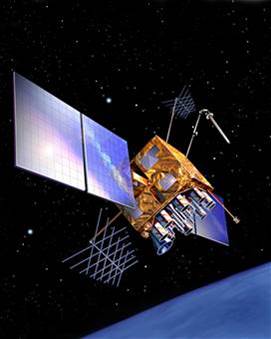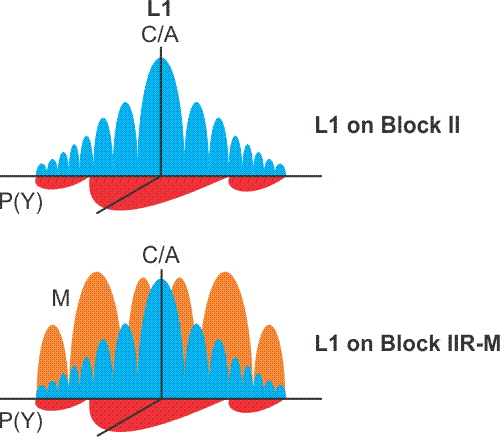
New Signals
An important aspect of GPS modernization is the advent of some new and different signals that are augmenting the old reliable codes. In GPS, a dramatic step was taken in this direction on September 21, 2005 when the first Block IIR-M satellite was launched. One of the significant improvements coming with the Block IIRM satellites is increased L-band power on both L1 and L2 by virtue of the new antenna panel. The Block IIR-M satellites will also broadcast new signals, such as the M-code.

The M-Code
Eight to twelve of these replenishment satellites are going to be modified to broadcast a new military code, the M-code. This code will be carried on both L1 and L2 and will probably replace the P(Y) code eventually. It has the advantage of allowing the Department of Defense (DoD) to increase the power of the code to prevent jamming. There was consideration given to raising the power of the P(Y) code to accomplish the same end, but that strategy was discarded when it was shown to interfere with the C/A code.
The M-code was designed to share the same bands with existing signals, on both L1 and L2, and still be separate from them. See those two peaks in the M-code in the illustration. They represent a split-spectrum signal about the carrier. Among other things, this allows minimum overlap with the maximum power densities of the P(Y) code and the C/A code, which occur near the center frequency. That is because the actual modulation of the M-code is done differently. It is accomplished with binary offset carrier (BOC) modulation, which differs from the binary phase shift key (BPSK) used with the legacy C/A and P(Y) signals. As a result of this BOC modulation, the M-code has its greatest power density at the edges, which is at the nulls, of the L1 away from P(Y) and C/A. This architecture both simplifies implementation at the satellites and receivers and also mitigates interference with the existing codes. Suffice it to say that this aspect and others of the BOC modulation strategy offer even better spectral separation between the M-code and the older legacy signals.
The M-code is unusual in that a military receiver can determine its position with the M-code alone, whereas with the P(Y) it must first acquire the C/A code to do so. It is also spread across 24 MHz of the bandwidth.
Perhaps it would also be useful here to mention the notation used to describe the particular implementations of the Binary Offset Carrier. It is characteristic for it to be written BOC (α, ß). Here the α indicates the frequency of the square wave modulation of the carrier, also known as the subcarrier frequency factor. The ß describes the frequency of the pseudorandom noise modulation, also known as the spreading code factor. In the case of the M-code, the notation BOC (10, 5) describes the modulation of the signal. Both here are multiples of 1.023 MHz. In other words, their actual values are.
.
The M-code is tracked by direct acquisition. This means that, as mentioned in Lesson 1, the receiver correlates the signal coming in from the satellite with a replica of the code that it has generated itself.
One of the significant improvements coming from the Block IIR-M satellites is increased L band power on both L1 and L2. This new M-Code will possibly replace the P-Code, eventually. It will be carried on both L1 and L2, and it has an advantage that the Department of Defense can increase the power of the code to prevent jamming. There was consideration to raising the power of the Y-Code to accomplish the same end, but that was discarded when it was shown to interfere with the C/A Code. So to recap, the M-Code will be carried on L1 and L2, but because of the binaries offset carrier modulation, it will not interfere with the older legacy codes, the C/A Code and P-Code.